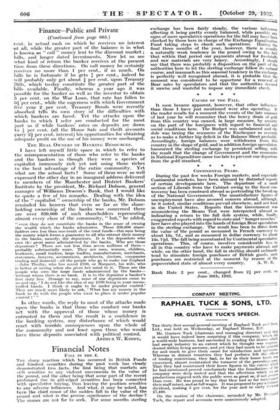How BANKERS' RESOURCES ARE USED.
If all, or even the greater part of the deposits were used in long-dated advances such assurance most cer- tainly could not be given and certainly not with industry in its present condition. Accordingly the banker has to keep the greater part of his resources liquid, which in plain language means that he has to keep about 10 per (Continued on page 606.)
Finance—Public and Private
(Continued from page 605.) -cent. in actual cash on which he receives no interest wit all, .while the greater part of the balance is in what is known as " call ' money .lent to the discount market ; bills, and longer dated investments. Now let us see what kind of return the banker receives at the present time from these directions. On call money he certainly -nceives no more than 1 per cent., if as much. On bills he is fortunate if he gets 4 per cent., indeed he will probably only get about per cent. upon Treasury Bills, which to-day constitute the greater part of the 'bills available. Finally, whereas a year ago it was possible for the banker as well as the investor to obtain 5 per cent, on the War Loan, that rate has fallen to 81 per cent., while the eagerness with which Government five year 2 _ per. cent. Treasury -Bonds were recently absorbed tells its own story of the difficulties with which bankers are faced. Yet the attacks upon the banks to which I . refer are conducted for the most part as if while bankers' rates on deposits are down to per cent. (all the Home Safe and thrift accounts carry 21 per cent. interest) his opportunities for obtaining adequate profit on the use of his money were unchanged. •













































 Previous page
Previous page